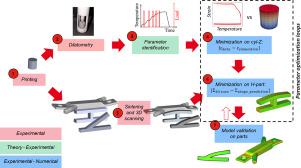A calibration method to predict shape change during sintering: Application to 316L parts made by Metal Binder Jetting
IF 11.1
1区 工程技术
Q1 ENGINEERING, MANUFACTURING
引用次数: 0
Abstract
Metal Binder Jetting (MBJ) is a promising sinter-based additive manufacturing technology allowing to produce parts with complex geometries in small to medium series. However, the required sintering step leads to a drastic shrinkage because of the initially low green density of the part () but also to large shape distortions due to gravity sagging. The prediction of those deformations is therefore paramount to reach near-net shape parts. A step-by-step method, relying on both experimental and numerical procedures, is proposed to predict shape changes during the sintering of 316L stainless steel made by MBJ. The anisotropic linear shrinkage is determined thanks to dilatometry while the viscous deformations are numerically fitted thanks to a calibration part. The numerical implementation is performed in the proprietary HP 3D Digital Sintering software and is tested for various sintering cycles. Optimization loops are proposed to fit correctly all the constitutive parameters leading to deviations of the simulated results with experimental parts below 1%. Then, angular sectors exhibiting various angles of overhangs are sintered to assess the performance of the model. It turns out that most predictions exhibit maximum deviations below 5%, with filleted parts exhibiting the better predictions. Beyond the model ability to predict shape, the parts proposed in this work show interesting features that allow to capture complex thermophysical mechanisms though they are of simple design. In this way, those could become standard calibration parts for any model for initial printing stages.

预测烧结过程中形状变化的校准方法:应用于金属粘结剂喷射316L零件
金属粘结剂喷射(MBJ)是一种很有前途的基于烧结的增材制造技术,可以生产具有复杂几何形状的中小批量零件。然而,所需的烧结步骤会导致剧烈的收缩,因为零件最初的生坯密度很低(≈50-60%),而且由于重力下垂也会造成很大的形状变形。因此,这些变形的预测对于达到接近净形状的零件是至关重要的。提出了一种采用实验和数值相结合的分步预测方法来预测MBJ法制备的316L不锈钢在烧结过程中的形状变化。各向异性线收缩率通过膨胀法确定,粘性变形通过标定部分进行数值拟合。数值实现是在专有的HP 3D数字烧结软件中进行的,并对各种烧结循环进行了测试。为了使模拟结果与实验零件的偏差小于1%,提出了优化回路以正确拟合所有本构参数。然后,烧结具有不同悬垂角度的角扇形来评估模型的性能。结果表明,大多数预测的最大偏差低于5%,而圆角部分的预测效果更好。除了模型预测形状的能力之外,这项工作中提出的部件显示出有趣的特征,尽管它们的设计很简单,但它们可以捕捉复杂的热物理机制。通过这种方式,这些可以成为任何模型初始打印阶段的标准校准部件。
本文章由计算机程序翻译,如有差异,请以英文原文为准。
求助全文
约1分钟内获得全文
求助全文
来源期刊

Additive manufacturing
Materials Science-General Materials Science
CiteScore
19.80
自引率
12.70%
发文量
648
审稿时长
35 days
期刊介绍:
Additive Manufacturing stands as a peer-reviewed journal dedicated to delivering high-quality research papers and reviews in the field of additive manufacturing, serving both academia and industry leaders. The journal's objective is to recognize the innovative essence of additive manufacturing and its diverse applications, providing a comprehensive overview of current developments and future prospects.
The transformative potential of additive manufacturing technologies in product design and manufacturing is poised to disrupt traditional approaches. In response to this paradigm shift, a distinctive and comprehensive publication outlet was essential. Additive Manufacturing fulfills this need, offering a platform for engineers, materials scientists, and practitioners across academia and various industries to document and share innovations in these evolving technologies.
 求助内容:
求助内容: 应助结果提醒方式:
应助结果提醒方式:


